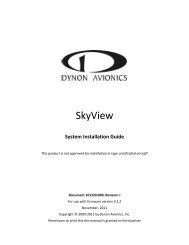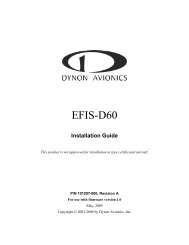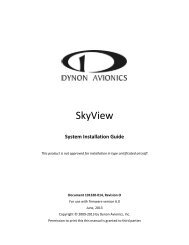EFIS-D100 Installation Guide - Dynon Avionics
EFIS-D100 Installation Guide - Dynon Avionics
EFIS-D100 Installation Guide - Dynon Avionics
Create successful ePaper yourself
Turn your PDF publications into a flip-book with our unique Google optimized e-Paper software.
Autopilot <strong>Installation</strong> and Configuration<br />
SERVO ELECTRICAL INSTALLATION<br />
<strong>Dynon</strong> <strong>Avionics</strong>’ servos are supplied with 7 un-terminated wires, each about 8” in length. It is<br />
the responsibility of the installer to decide on connectors and associated wiring. The 7 wires have<br />
the following colors and functions:<br />
Color Function Notes<br />
Red Power 10-30 volts DC. Each servo draws up to 2 amps<br />
Black Aircraft Ground Each servo draws up to 2 amps<br />
Green<br />
<strong>Dynon</strong> Smart <strong>Avionics</strong> Connected in parallel with other DSAB devices<br />
Bus [DSAB] “A” (Green wire on all <strong>Dynon</strong>-supplied wiring harnesses)<br />
Blue<br />
<strong>Dynon</strong> Smart <strong>Avionics</strong> Connected in parallel with other DSAB devices<br />
Bus [DSAB] “B” (Blue wire on all <strong>Dynon</strong>-supplied wiring harnesses)<br />
Yellow<br />
White/Green<br />
White/Blue<br />
AP Disengage/Control<br />
Wheel Steering (CWS)<br />
Button<br />
Reserved for<br />
compatibility with<br />
<strong>Dynon</strong> “Next<br />
Generation” products<br />
Reserved for<br />
compatibility with<br />
<strong>Dynon</strong> “Next<br />
Generation” products<br />
Connected through a normally-open pushbutton<br />
switch to Ground (disengages AP when button is<br />
pushed). If two servos are installed, the yellow wire<br />
from each servo is connected in parallel to a single<br />
pushbutton.<br />
DO NOT CUT! During servo installation, <strong>Dynon</strong><br />
recommends that this be routed to the cockpit panel<br />
(include sufficient slack behind the panel) if you<br />
want to preserve compatibility of the servo with<br />
<strong>Dynon</strong>’s “Next Generation” technology. This wire is<br />
not used with the <strong>EFIS</strong>-<strong>D100</strong>.<br />
DO NOT CUT! During servo installation, <strong>Dynon</strong><br />
recommends that this be routed to the cockpit panel<br />
(include sufficient slack behind the panel) if you<br />
want to preserve compatibility of the servo with<br />
<strong>Dynon</strong>’s “Next Generation” technology. This wire is<br />
not used with the <strong>EFIS</strong>-<strong>D100</strong>.<br />
Circuit Breaker/Switch: We recommend that electrical power for the all servos be protected<br />
with an appropriately sized circuit breaker or switch that is accessible to the pilot while in<br />
flight.<br />
Wire Sizing: While it is beyond the scope of this installation guide to advise on specific<br />
types of wiring for a particular aircraft, choice of wiring should be sized to 1) minimize<br />
voltage drop over the length of the particular wiring run, and 2) conduct the amount of<br />
current required by the subsystem without the wiring becoming warm to the touch.<br />
Wiring <strong>Installation</strong>: Care should be taken such that aircraft wiring is not subjected to<br />
chafing, excessive flexing, or connections / junctions subjected to excessive vibration which<br />
may cause the connection/junction to fail or short-circuit. If the White/Green and White/Blue<br />
wires are extended to the cockpit panel, leave sufficient slack behind the panel for connection<br />
anywhere behind the panel. If the White/Green and White/Blue wires are not extended to the<br />
cockpit panel, as with other unused wires, DO NOT CUT the wires, but rather insulate the<br />
ends of the wires (electrical tape, heatshrink tubing), bundle, and secure the unused wire.<br />
6-4 <strong>EFIS</strong>-<strong>D100</strong> <strong>Installation</strong> <strong>Guide</strong>
















